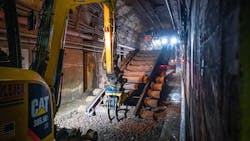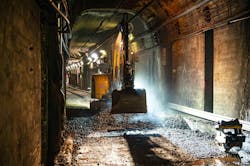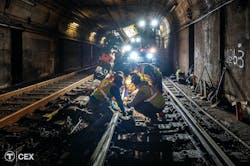MBTA shutdown on Green Line to complete critical track work successful
The Massachusetts Bay Transportation Authority (MBTA) has completed critical track work on the Green Line, which removed 16 safety-related speed restrictions – one more than planned. Additionally, a 17th speed restriction on the Green Line between Haymarket and Government Center stations was significantly shortened by more than 500 feet.
Crews accomplished the critical work due to unencumbered access to track areas while Green Line train service was suspended on the B branch from Babcock Street to Kenmore, on the E branch between Heath Street and Copley and in the downtown area between Kenmore and North Station for 10 days from Jan. 3 through Jan. 12 and for 13 days from Jan. 16 through Jan. 28.
Additionally, during scheduled weekend and evening service diversions during the last several weeks between North Station and Union Square, as well as Medford/Tufts, crews from GLXC, the design-build contractor, have completed critical track work that has alleviated all current tight gauge conditions along both Green Line Extension branches.
“I’m proud of the work our crews were able to accomplish during this most recent Green Line shutdown – the Green Line tunnel in the downtown area received tremendous maintenance and attention that will have a generational impact on current and future riders and we were able to tackle this critical work thanks to the unencumbered access to the track area,” said MBTA General Manager and CEO Phillip Eng. “Importantly, our team was able to lift even more speed restrictions than were planned and significantly shorten another. This continues to be indicative of the new way the MBTA is doing business. I thank our riders for their patience, as we know shuttle bus service replacement can be challenging, especially in the winter months. Thank you as well to the MBTA forces, working side by side with our crews from multiple contractors to deliver on the commitments we made.”
Crews continued to maximize the Green Line shutdown in several ways. With unencumbered access to Green Line stations, crews were able to accomplish station enhancements and amenity upgrades such as new flooring and lighting, which further improved the customer experience. Additionally, through extensive planning and close coordination between contractor crews and multiple MBTA Operations departments, the MBTA was able to maximize the shutdown time by having several contractor crews and MBTA personnel working side-by-side and collaboratively within the very tight and confined underground Green Line tunnel area to be as efficient as possible during the shutdown in service.
Among the critical work:
- More than 1,300 crossties were replaced.
- Nearly 10,800 feet of rail was replaced.
- Nearly 8,900 feet of track was resurfaced and tamped.
- 12 switches were replaced/rehabilitated.
- Approximately 7,300 feet of overhead catenary wire was replaced between Haymarket and Boylston stations.
- Structural repairs were completed on the roofs of Boylston and Copley stations.
- Tunnel inspections were performed between Haymarket and North Station.
- At Copley station, repair work was completed on three in-station columns with additional infrastructure upgrades accomplished.
- A new elevator sump pump was installed at Arlington station.
- Substation maintenance and electrical repairs were completed.
- Water infiltration repairs were completed within the Green Line tunnel.
- Critical signal and power system repairs were completed.
- Improvements were accomplished at the Park Street communication room.
- Structural inspections were accomplished at stations throughout the Green Line shutdown.
A variety of other in-station work also took place along the Green Line to further enhance the rider experience, including cleaning, sanding and painting wood benches, performing tactile repairs, stairway upgrades and repairs, including handrail repairs, installing/replacing station signage, painting columns and ceilings at station platforms, painting stair risers, doors and door frames, performing flooring/tile repairs, replacing lights, patching spalls on concrete columns and replacing/cleaning light covers.
The MBTA further maximized the shutdown by coordinating site access with utility partners. With the service shutdown, Comcast was able to safely access property adjacent to the MBTA to expand maintenance access points and upgrade existing equipment, which was a project that had been previously delayed nine months. The Boston Water and Sewer Commission also completed CCTV inspections of 20 maintenance access points and connecting sewer lines of the utility network between Brigham Circle and Health Street stations along Huntington and South Huntington Avenues.
The full list of removed safety-related speed restrictions can be found on MBTA’s website.



